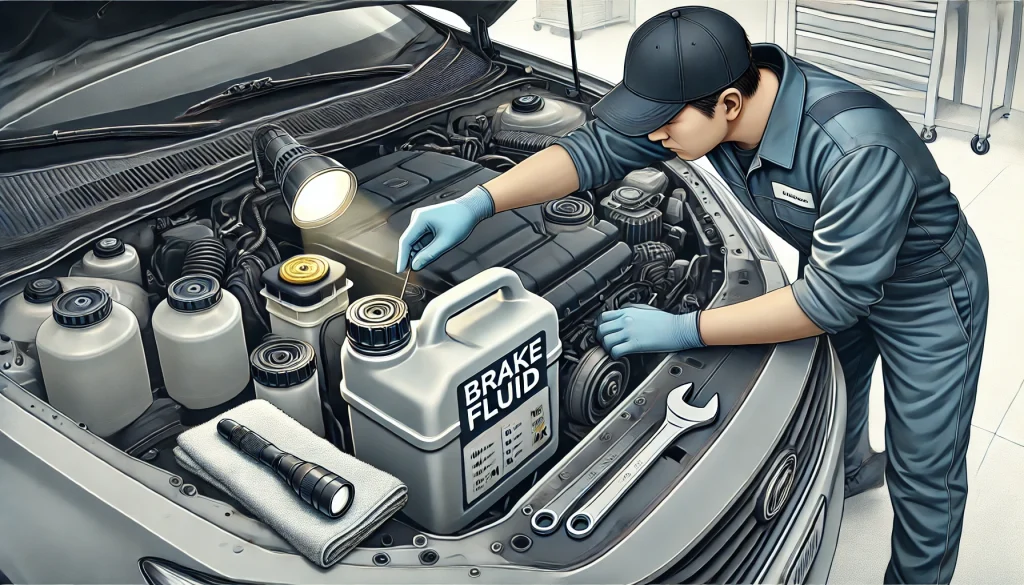Brake fluid is a critical component of your vehicle’s braking system, ensuring that your brakes function properly and safely. Regularly checking the brake fluid levels is a simple yet essential task for maintaining your car’s performance. In this comprehensive guide, we will provide a step-by-step process on how to check and top up your brake fluid. By following these easy steps, you’ll ensure your vehicle’s brakes are in top condition, enhancing both safety and efficiency.
Find Your Vehicle’s Engine Bay
The first step in checking your brake fluid is locating your vehicle’s engine bay. Typically, the engine bay is located at the front of the car under the bonnet. If you’re unsure where to find it, consult your vehicle’s handbook for guidance. Once you’ve identified the engine bay, you can proceed with the next steps.
Locate Your Vehicle’s Brake Fluid Reservoir
Next, you need to find the brake fluid reservoir within the engine bay. This reservoir is usually situated at the rear of the engine bay and can be on either the driver’s or passenger’s side. The reservoir typically looks like a small container with a black screw-on lid that has yellow icons, often an octagonal shape with a circle and brackets. The reservoir should be semi-translucent, with markings indicating the minimum and maximum fluid levels.
Check Your Brake Fluid Level
To check the brake fluid level, look at the markings on the side of the brake fluid reservoir. It’s time to add more fluid if the level is below the minimum. Clean brake fluid should have a slightly golden color, although it may be hard to see if the reservoir is dirty. Make sure the outside of the reservoir is clean for a better view of the fluid inside.
Top Up Using Correct Brake Fluid
When topping up the brake fluid, it’s crucial to use the correct type. There are several types of brake fluid, including DOT 3, DOT 4, DOT 5, and DOT 5.1. Refer to your vehicle’s handbook to determine the appropriate type for your car. Use a funnel to pour the brake fluid carefully into the reservoir, filling it to the maximum mark. Be cautious to avoid spillage, as brake fluid can damage your car’s paint. If any fluid spills, clean the surface thoroughly.
Be Wary of the Signs
Low brake fluid levels can indicate worn brakes or a potential leak. Regularly topping up the brake fluid may suggest a leak in the system, which requires immediate attention. If you notice that you need to top up the brake fluid frequently, have your vehicle inspected by a professional to identify and fix any leaks. Additionally, low brake fluid can lead to decreased braking performance, so it’s essential to address this issue promptly.
Clean and Close
After topping up the brake fluid, ensure that the reservoir lid is sealed properly. Clean any spillages around the reservoir and the engine bay. Keeping the area clean helps prevent contamination and ensures the brake fluid remains in good condition.
How to Check Your Brake Fluid?
Let’s review the entire process in a simple, step-by-step manner:
Find Your Vehicle’s Engine Bay: Locate the engine bay at the front of your car under the bonnet.
Locate the Brake Fluid Reservoir: Look for a semi-translucent container with a black screw-on lid and yellow icons.
Check the Fluid Level: Ensure the brake fluid is between the minimum and maximum marks.
Top Up Using Correct Brake Fluid: Use the appropriate type of brake fluid, and fill to the maximum mark without spilling.
Be Wary of Signs: Monitor for frequent topping up needs, which could indicate leaks or worn brakes.
Clean and Close: Seal the reservoir lid tightly and clean any spills.
What Type of Brake Fluid to Use?
Selecting the correct type of brake fluid is crucial for the proper functioning of your vehicle’s braking system. Here’s a breakdown of the common types of brake fluid:
DOT 3: Glycol-based fluid suitable for most vehicles. It has a lower boiling point compared to DOT 4 and DOT 5.1.
DOT 4: Also glycol-based, but with a higher boiling point than DOT 3, making it suitable for vehicles that undergo more stress, such as performance or heavy-duty vehicles.
DOT 5: Silicone-based and does not absorb moisture, but it is not compatible with DOT 3 or DOT 4 systems. It’s often used in classic cars or military vehicles.
DOT 5.1: Glycol-based like DOT 3 and DOT 4, but with the highest boiling point. It is used in high-performance and racing vehicles.
Always refer to your vehicle’s handbook to determine the suitable brake fluid type.
Why is Brake Fluid Important?
Brake fluid is a hydraulic fluid that transfers the force applied to the brake pedal into pressure, which then brings your vehicle to a stop. It is essential for:
Maintaining Braking Efficiency: Brake fluid ensures that the brakes respond promptly and effectively.
Preventing Corrosion: High-quality brake fluid prevents corrosion within the braking system, extending the lifespan of the components.
Operating Under Extreme Conditions: Brake fluid must perform under various temperatures and conditions without losing its effectiveness.
Regularly checking and maintaining the brake fluid level ensures that your braking system remains reliable and efficient.
What Happens if Brake Fluid is Low?
Driving with insufficient brake fluid might have detrimental effects:
Reduced Braking Performance: Low fluid levels can lead to a spongy brake pedal, increased stopping distances, or even brake failure.
Overheating Brakes: Insufficient brake fluid can cause the brakes to overheat, leading to brake fade and potential damage to brake components.
Safety Risks: Poor braking performance increases the risk of accidents, endangering both you and other road users.
If you suspect low brake fluid levels, address the issue immediately to ensure your safety on the road.
How Often Should You Check Brake Fluid?
It’s recommended to check your brake fluid level at least once a month or every time you perform regular vehicle maintenance, such as oil changes. Regular checks help you identify potential issues early and maintain optimal braking performance.
| Tips for Maintaining Brake Fluid Levels | |
| Regular Checks | Check your brake fluid levels monthly to ensure they are within the recommended range. |
| Use Correct Fluid | Always use the brake fluid specified in your vehicle’s handbook to prevent damage and ensure optimal performance. |
| Monitor Brake Performance | Pay attention to changes in braking performance, such as reduced responsiveness or increased stopping distance |
| Clean Spills Immediately | Clean any spilled brake fluid promptly to avoid damage to your vehicle’s paint and components. |
| Address Leaks Promptly | If you suspect a leak, have your vehicle inspected by a professional mechanic to prevent brake failure. |
Final Thoughts
Regularly checking and maintaining the brake fluid levels in your car is vital for safe and efficient braking performance. By following these straightforward steps, you can ensure your brakes function correctly and avoid potential accidents. Remember, if you’re unsure about any aspect of this process or notice persistent issues, it’s always best to consult a professional mechanic.


